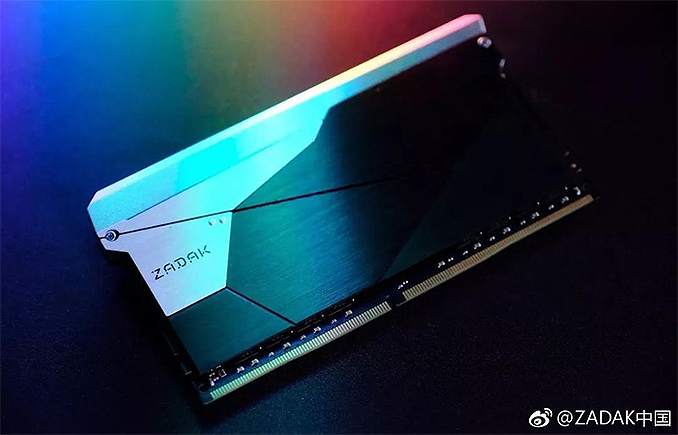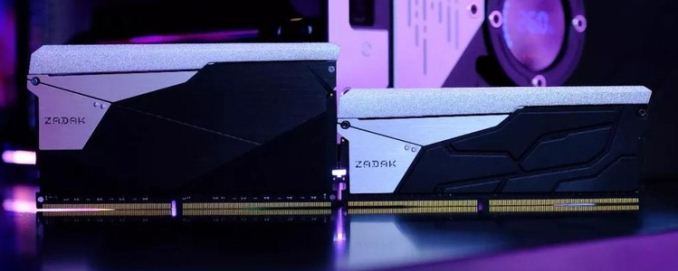Double Height, Double Capacity DDR4? ZADAK's New 32 GB UDIMMs
by Anton Shilov on September 28, 2018 10:00 AM EST
ZADAK, a maker of memory modules from Taiwan, has reportedly published photos of its upcoming unbuffered memory modules featuring a 32 GB capacity. The UDIMMs and SO-DIMMs are the first consumer-grade 32 GB memory sticks to feature RGB lighting. The main intrigue about the modules is how ZADAK managed to build them ahead of many rivals.
This week the Chinese subsidiary of ZADAK published the first images of the company’s Shield DC Aura2 RGB-branded 32 GB UDIMM and SO-DIMM on its Weibo page. The modules are rated at DDR4-3200 MT/s (unknown subtimings), and are outfitted with large aluminum heat spreaders featuring RGB lightbars.
So far, only Samsung has introduced 32 GB consumer-grade non-ECC DDR4 UDIMMs and SO-DIMMs. Samsung's modules are based on the company’s 16 Gb DDR4 chips and are available to select customers only. Other leading suppliers of memory modules, including Corsair, G.Skill, GEIL, and others, only offer 16 GB consumer-graded non-ECC unbuffered modules based on 4 or 8 Gb devices. In order for Zadak to impliment 32GB modules ahead of its rivals, it would need one of two things: Samsung's 16Gb chips, or a new technology. By going the double height route, it is clear that they are using a different technology to increase capacity.
It is worth noting that 32GB-256GB modules already exist for servers and workstations, but these are RDIMMs , with a register chip and ECC, and is a different technology from the standard 'unbuffered' DIMMs for home computers. RDIMMs enable memory controllers to support a higher amount of memory chips without losing stability, which is why almost all RDIMMs typically also feature ECC.
ZADAK does not disclose which DRAMs it uses for its 32 GB Shield DC Aura2 RGB modules, and we're waiting on more information from them although there is a bit of a translation barrier - when asked for information, we were told 'it's a new technology' without any expansion. Considering how large ZADAK’s 32 GB SO-DIMMs are, it is possible that they are based on 32 8 Gb DRAM and feature a register chip to enable systems to work with the modules stably. It is also possible that Samsung has started to sell its 16 Gb chips to third parties and ZADAK is among the first to start teasing potential customers with high-capacity modules, and the best way to advertise this was super big memory PCBs.
While 32 GB consumer-grade memory modules certainly look impressive on paper, their practical usability is potentially limited. Mainstream client CPUs only officially support up to 64 GB of memory, and systems that need 64 GB of RAM usually have four DIMM slots. As a result, client PCs do not necessarily need 32 GB modules just now. Furthermore, given the current prices of DRAM, specialty 32GB DIMMs like these will be anything but cheap. However it may point to CPUs that support double current capacity points in the future.
Related Reading:
- Samsung Adds 32 GB UDIMMs to Memory Lineup
- Samsung Kicks Off Mass Production of 64GB RDIMMs Using 16Gbit Chips
- Samsung Unveils 32 GB DDR4-2666 SO-DIMMs
- Samsung Demos 64 GB RDIMM Based on 16 Gb Chips, Promises 256 GB LRDIMMs
Source: PC Watch












19 Comments
View All Comments
PeachNCream - Friday, September 28, 2018 - link
The extra capacity is nice, but there might be some limits for people that installed very large HSFs in their systems. Also, this doesn't mean a lot for the laptop space where the vast majority of computers sold exist. It's actually sort of difficult to purchase a desktop aside from various small form factor systems that use SODIMMs and M.2 or 2.5 inch SATA drives in US retail spaces.nathanddrews - Friday, September 28, 2018 - link
As I understand things - based on following PC builders blogs/YT channels - no one is asking for taller memory modules. It's already hard enough to fit coolers over existing RGB heat spreaders. Who are these for?notashill - Friday, September 28, 2018 - link
Obviously it's a pretty niche thing. The main use case I see is ITX builds with 64GB of RAM, most of those boards only have 2 DIMM slots. Clearance is not an issue if you use liquid cooling.nathanddrews - Friday, September 28, 2018 - link
If RAM capacity is mission critical and you can afford these along with water cooling, it seems like a total waste to go with anything less than a larger chassis with at least four slots. That's quite the niche! I'm not saying the niche doesn't exist or that people shouldn't do it - I've just never seen such a niche before. Somewhere out there, 62 people just got really excited. ;-)ballsystemlord - Saturday, September 29, 2018 - link
You mean 64. It's a power of 2. (:0ldman79 - Friday, September 28, 2018 - link
How many boards can run 32GB DIMMs?I'm pretty sure all of mine are limited to 8GB per DIMM (DDR3 though).
Most that support 64GB top out at 16GB per DIMM and have 4 slots.
wolrah - Friday, September 28, 2018 - link
@0ldman79 most boards will probably run them just fine. Motherboard vendors tend to be conservative with their official support statements. If they haven't tested with a 32GB DIMM, they'll call it unsupported.Ian Cutress - Friday, September 28, 2018 - link
The taller modules give double the capacity, so it's for the people who want capacity. It's not a style thing.nathanddrews - Friday, September 28, 2018 - link
*ahem* RGBrocky12345 - Friday, September 28, 2018 - link
Ian without RGB will they perform slower and lose 5% raw performance because of them missing the blinking lights? /joking of coarse. I can see a use case for these for a small group of people and probably content providers that edited large video files that huge amounts of memory I guess.